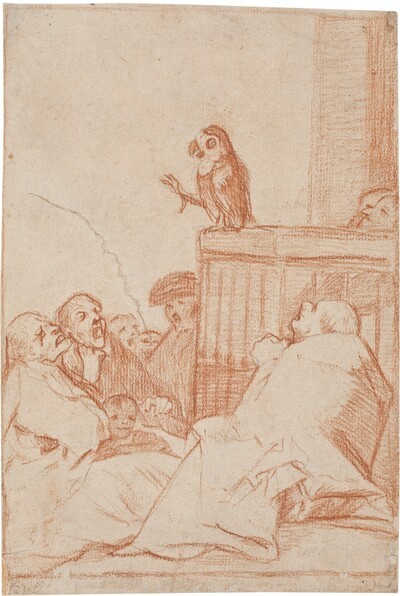- Cronología
- Ca. 1797 - 1799
- Dimensiones
- 218 x 121 mm
- Técnica y soporte
- Aguafuerte, aguatinta bruñida y buril
- Reconocimiento de la autoría de Goya
- Undisputed work
- Ficha: realización/revisión
- 22 Dec 2010 / 29 May 2024
- Inventario
- 225
Que pico de Oro! (at the bottom)
53. (in the upper right-hand corner)
See Francisco de Goya y Lucientes, Painter.
Only one state proof with etching and aquatint, before the additional burnishing and burin, has survived in the Prado Museum.
A preparatory drawing for this engraving has come down to us from the Prado Museum.
A parrot rests on a pulpit and delivers a sermon with one leg outstretched. The audience, made up of old monks, is rapt. All of them have their mouths open, except for a monk wearing a bonnet, who is standing next to the pulpit, under the animal. The latter looks on with a gesture of displeasure, seeming to pay no attention to the trickster's palaver.
Goya has made an appropriate use of technique to create intense contrasts of light and shade. He uses medium-toned aquatint on the thigh of the figure on the left and burin to accentuate the contours of the figures as well as the small details such as the knuckles or a fingernail of the second figure on the left.
The manuscripts offer a double explanation of this image; the one in the Prado Museum states the following: "This has traces of an academic board. Who knows if the parrot is talking about medicine, but one should not take him at his word. There is a doctor who is a golden beak when he speaks and a Herod when he prescribes: he speaks perfectly of ailments and does not cure them: he dupes the sick and fills the cemeteries with pumpkins". However, a different interpretation of this work is proposed in the National Library: "The friars are regularly plagiaristic preachers; but since they praise each other so much, the foolish audience is open-mouthed".
Edith Helman believes that the source of inspiration for this engraving could be History of the Famous Preacher Gerundio Campazas (1758) by José Francisco Isla de la Torre y Rojo (Vidanes, 1703-Bologna, 1781). In this work he censures ecclesiastical orators who were preaching to the public with rhetorical extravagances in bad taste.
The plate is in poor condition, with the aquatint worn (National Chalcography, no. 224).
-
De grafiek van GoyaRijksmuseum RijksprentenkabinetAmsterdam1970from November 13th 1970 to January 17th 1971cat. 39
-
El arte de GoyaMuseo de Arte Occidental de TokioTokyo1971from 16th 1971 to January 23th 1972. Exhibited also at the Kyoto Municipal Museum of Art, January 29th to March 15th 1972.cat. 78
-
Goya. La década de Los CaprichosMadrid1992organized by Real Academia de Bellas Artes de San Fernando sponsored by Fundación Central Hispano, Madrid, consultant editor Nigel Glendinnig. From October 26th 1992 to January 10th 1993cat. 114
-
GoyaNationalmuseumStockholm1994consultant editors Juan J. Luna and Görel Cavalli-Björkman. From October 7th 1994 to January 8th 1995cat. 68
-
Francisco de GoyaMuseo d'Arte ModernaLugano1996exhibition celebrated from September 22nd to November 17th.cat. 53, p.80
-
Ydioma universal: Goya en la Biblioteca NacionalBiblioteca NacionalMadrid1996from September 19th to December 15th 1996cat. 140
-
Francisco Goya. Sein leben im spiegel der graphik. Fuendetodos 1746-1828 Bordeaux. 1746-1996Galerie KornfeldBern1996from November 21st 1996 to January 1997cat. 58
-
Goya artista de su tiempo y Goya artista únicoThe National Museum of Western ArtTokyo1999from December 1st to July 3th 1999cat. 128
-
Goya e la tradizione italianaFondazione Magnani RoccaMamiano di Traversetolo (Parma)2006consultant editors Fred Licht and Simona Tosini Pizzetti. From September 9th to December 3th 2006cat. 53, p.159
-
Goya. Opera graficaPinacoteca del Castello di San GiorgioLegnano2006exhibition celebrated from December 16th 2006 to April 1st 2007p.38
-
Goya e ItaliaMuseo de ZaragozaZaragoza2008organized by the Fundación Goya en Aragóna, consultant editor Joan Sureda Pons. From June 1st to September 15th 2008cat. 335
-
Goya et la modernitéPinacothèque de ParisParís2013from October 11st 2013 to March 16th 2014cat.9
-
Goya engravings and lithographs, vol. I y II.OxfordBruno Cassirer1964pp.127-128, cat. 88
-
Vie et ouvre de Francisco de GoyaParísOffice du livre1970p.182, cat. 557
-
Goya, la década de los caprichos: dibujos y aguafuertesMadridReal Academia de Bellas Artes de San Fernando1992pp.192-195, cat. 113-115
-
Catálogo de las estampas de Goya en la Biblioteca NacionalMadridMinisterio de Educación y Cultura, Biblioteca Nacional1996p.101, cat. 142
-
El libro de los caprichos: dos siglos de interpretaciones (1799-1999). Catálogo de los dibujos, pruebas de estado, láminas de cobre y estampas de la primera ediciónMadridMuseo Nacional del Prado1999pp.282-285
-
ParísPinacoteca de París2013p. 67
-
Goya. In the Norton Simon MuseumPasadenaNorton Simon Museum2016pp. 42-75

